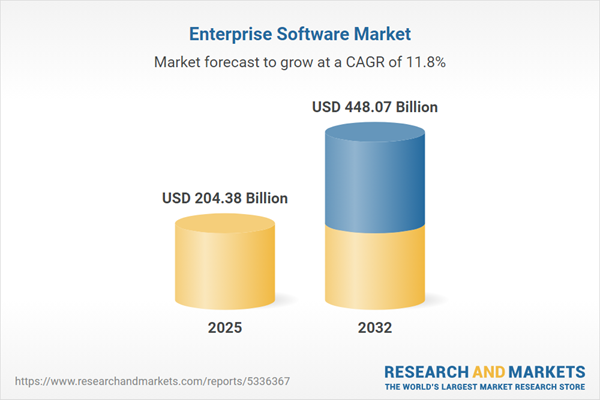Speak directly to the analyst to clarify any post sales queries you may have.
The enterprise software market is undergoing rapid transformation, shaped by evolving business needs and accelerating technological advancements. Senior decision-makers must adapt to dynamic market drivers and the growing demand for integrated digital solutions to maintain a competitive edge in this shifting landscape.
Market Snapshot: Enterprise Software Growth and Momentum
The Enterprise Software Market grew from USD 183.66 billion in 2024 to USD 204.38 billion in 2025. It is projected to expand at a CAGR of 11.79%, reaching USD 448.07 billion by 2032.
Scope & Segmentation
This report provides a detailed analysis of the enterprise software market across multiple dimensions, offering actionable segmentation for targeted strategies:
- Product: Business Intelligence, Business Process Automation, Content Management Software, Customer Relationship Management (CRM), Enterprise Resource Planning (ERP), Supply Chain Management (SCM)
- Platform: Desktop, Mobile
- Business Function: Finance & Accounting, Human Resources (HR) & Workforce Management, IT & Infrastructure Management, Legal, Compliance & Risk Management, Operations & Supply Chain Management, Project & Portfolio Management, Sales & Marketing
- Deployment Model: Cloud-Based, On-Premises
- Enterprise Size: Large Enterprises, Small & Medium Enterprises
- End User: Banking, Financial Services & Insurance (BFSI), Education & e-Learning, Energy & Utilities, Government & Public Sector, Healthcare & Life Sciences, Hospitality & Travel, IT & Telecommunications, Manufacturing & Industrial, Media & Entertainment, Real Estate & Construction, Retail & E-commerce, Transportation & Logistics
- Region: Americas (including United States, Canada, Mexico, Brazil, Argentina, Chile, Colombia, Peru), Europe, Middle East & Africa (including the United Kingdom, Germany, France, Russia, Italy, Spain, Netherlands, Sweden, Poland, Switzerland, United Arab Emirates, Saudi Arabia, Qatar, Turkey, Israel, South Africa, Nigeria, Egypt, Kenya), Asia-Pacific (including China, India, Japan, Australia, South Korea, Indonesia, Thailand, Malaysia, Singapore, Taiwan)
Emerging technologies such as artificial intelligence, low-code platforms, and advanced analytics are reshaping usage across segments, while regional nuances drive adoption patterns and vendor strategies.
Key Takeaways for Enterprise Software Strategy
- Digital transformation is accelerating, prompting organizations to modernize workflows and optimize operations through real-time data integration and enhanced process automation.
- Cloud-native architectures support flexible deployment and improved scalability, with hybrid and multi-cloud models gaining traction for both regulated and agile environments.
- Security protocols and compliance automation are essential as enterprises address new threat vectors and increasingly distributed workforces, especially in sectors with heightened data sensitivity.
- Industry-specific solutions and modular design approaches allow enterprises to customize software portfolios, aligning technology investments with unique operational objectives without extensive redevelopment.
- Collaborative and mobile-enabled platforms are in high demand as remote work and workforce decentralization reshape organizational structures, impacting both user experience and operational continuity.
- Vendor consolidation and strategic partnerships are influencing competitive landscapes, while alliances and open APIs foster interoperability and drive ongoing innovation.
Tariff Impact on Procurement and Supply Chain
Recent tariff adjustments in the United States have introduced complexities around enterprise software procurement. Increased duties on imported technology drive up sourcing costs and affect licensing and maintenance agreements for global organizations. Many vendors are enhancing regional operations and localizing infrastructure to mitigate exposure and ensure compliance. Procurement leaders are adopting flexible strategies, including contract renegotiation and scenario-based risk planning, to navigate these evolving challenges effectively.
Methodology & Data Sources
This report is based on a hybrid research methodology that includes comprehensive secondary research, expert interviews, and primary data collection from enterprise technology buyers worldwide. Structured analysis and triangulation ensure the accuracy and rigor of the insights presented.
Why This Report Matters
- Enables senior decision-makers to anticipate, plan, and capitalize on digital transformation and regulatory shifts impacting the enterprise software market.
- Supports the alignment of technology investments with business priorities, leveraging leading-edge and emerging solutions for measurable outcomes in complex environments.
- Provides an in-depth competitive overview to help organizations refine vendor relationships and strategic alliances for greater operational resilience.
Conclusion
The enterprise software market is evolving rapidly, presenting both complex challenges and significant opportunities for growth. This report delivers the strategic perspectives needed to inform proactive decision-making and secure sustained competitive advantage.
Additional Product Information:
- Purchase of this report includes 1 year online access with quarterly updates.
- This report can be updated on request. Please contact our Customer Experience team using the Ask a Question widget on our website.
Table of Contents
3. Executive Summary
4. Market Overview
7. Cumulative Impact of Artificial Intelligence 2025
Companies Mentioned
The companies profiled in this Enterprise Software market report include:- Accenture PLC
- Adobe, Inc.
- Asana, Inc.
- Atlassian
- Autodesk Inc.
- Broadcom Inc.
- Cisco Systems Inc.
- Cloud Software Group, Inc.
- Creative Web Mall India Pvt. Ltd.
- Deltek, Inc.
- Enterprise Software Solutions
- Epicor Software Corporation
- Fingent
- Hewlett Packard Enterprise
- IBM Corporation
- Improsys
- Infor
- Microsoft Corporation
- Oracle Corporation
- Salesforce, Inc.
- SAP SE
- ServiceNow, Inc.
- STERP
- SYSPRO
- Workday, Inc.
- Zendesk, Inc.
- Zoho Corporation Pvt. Ltd.
Table Information
| Report Attribute | Details |
|---|---|
| No. of Pages | 188 |
| Published | November 2025 |
| Forecast Period | 2025 - 2032 |
| Estimated Market Value ( USD | $ 204.38 Billion |
| Forecasted Market Value ( USD | $ 448.07 Billion |
| Compound Annual Growth Rate | 11.7% |
| Regions Covered | Global |
| No. of Companies Mentioned | 28 |









